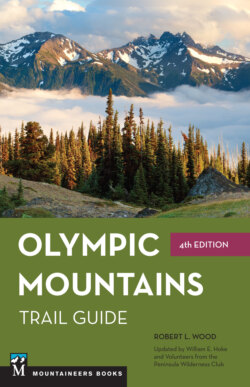Читать книгу Olympic Mountains Trail Guide - Robert Wood - Страница 16
На сайте Литреса книга снята с продажи.
THE OLYMPIC FORESTS
ОглавлениеThe Olympic Mountains are renowned for the stands of fir, hemlock, cedar, and spruce that clothe their flanks on all sides but attain their climax in the rain forests of the western valleys. The Olympic trees are part of the great conifer forest that parallels the Pacific coast of North America from southern Alaska to central California. Except for the high mountain district, the entire peninsula was once covered by unbroken stands of virgin forest, but most of the trees have been destroyed by logging operations since the coming of Europeans. The best of the remaining old growth is found on the river bottoms and the lower slopes within Olympic National Park.
Douglas-fir grows everywhere in the mountains, but it is most abundant on the northern, eastern, and southern sides up to about 3000 feet altitude. Fire creates conditions favorable to the reproduction of this species, which requires sunlight and mineral soil. Thus one finds Douglas-fir flourishing where fires have raged in the past. Conversely, western red cedar occurs principally on wet flatlands and valley bottoms, and Sitka spruce is confined almost exclusively to the west-side lowlands, which receive excessive rainfall and summer fogs. The fir, cedar, and spruce are the largest trees in the Olympics, frequently surpassing 250 feet in height and 10 feet in diameter. Western hemlock, a smaller tree, is probably the most abundant species because it thrives in dense shade. Of the true firs, Pacific silver fir is common throughout intermediate elevations, but grand fir is comparatively rare.
The high-altitude conifers—subalpine fir, mountain hemlock, and Alaska yellow cedar— display varied characteristics. The fir and hemlock are spire shaped, with stiff trunks that resist breakage caused by the heavy burden of snow. Alaska yellow cedar has a different pattern of growth. The foliage droops, and the limber trunk bends readily under the weight of snow without breaking. Pacific madrona, a broadleaf evergreen, grows at lower elevations throughout the Olympics, but it is most common on the drier northern and eastern slopes.
Deciduous trees include red alder, bigleaf and vine maples, and black cottonwood. They thrive on river bottoms, particularly alongside streams, but occasionally grow elsewhere. Red alder, which prepares new ground for conifers, is the most abundant broad-leaved tree. Bigleaf maple is a large tree with a sturdy trunk and huge leaves that turn yellow in the autumn, but vine maple is a small, sprawling tree that could almost be characterized as a large shrub. The largest deciduous tree is the black cottonwood, but it is not numerous. Almost invariably found along streams, it frequently attains a diameter of 4 to 6 feet and heights of 180 feet.
The Olympic forests contain several trees recognized by the American Forestry Association as the largest-known examples of their species. However, tree champions wear uneasy crowns— they have to face not only the prospect of destruction by nature (wind, fire, or flood) or by humans (fire, logging, or road building) but also the possibility that a larger specimen may be discovered elsewhere. Consequently, the champions change from time to time.
On occasion, in the past, as many as six or eight record-size trees in the Olympic Mountains have been recognized simultaneously by the association. Most of the champions have been conifers, located within the boundaries of the national park, but occasionally a deciduous tree has held the crown. Because the trees having championship status vary from one decade to another, even from year to year, no listing is given here of the current title holders inasmuch as such a list would, in all probability, become obsolete in the near future.
Snags and hollow trees are common in the virgin forest, in marked contrast to their absence in second-growth stands. Such trees were once considered useless, but they are now recognized as having great value because they provide both food and shelter for many woodland creatures. For example, woodpeckers carve holes in standing dead trees, either to make cavities for nesting purposes or to search for insects. After the holes have been abandoned, they provide homes for other birds and small woodland creatures.
